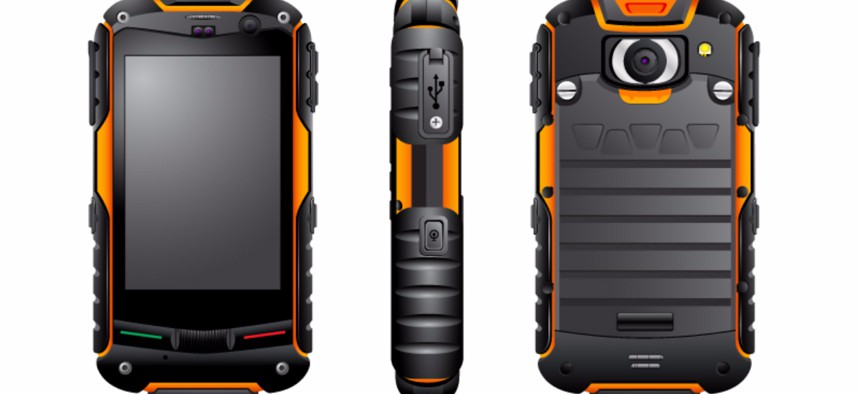What Government Buyers Need to Know About Rugged Devices

AVitko/Shutterstock.com
There are lots of little nuances that buyers should know when evaluating rugged gear.
John Breeden II is an award-winning journalist and reviewer with over 20 years of experience covering technology. He is the CEO of the Tech Writers Bureau, a group that creates technological thought leadership content for organizations of all sizes. Twitter: @LabGuys
I was watching some of the post-Hurricane Irma coverage and saw an aid worker with a standard iPhone, which they had protected with a rugged case. She was using an app to track the inventory of supplies her organization was distributing, so it would be safe to classify the phone as mission critical in that instance. Now, I have nothing against OtterBox or other protective cases and have used many in the past. If you have a non-rugged device, adding a case that can serve to protect it against the shock of a sudden drop, or depending on the model, against water ingress or immersion, is a smart move. But that does not make a phone rugged.
Government buyers, or anyone who needs to face a challenging environment, should take steps to protect their electronic devices. Even if your job rarely requires you to leave the office, having a little extra protection for your fragile smartphone or tablet isn’t a bad idea. But people like that aid worker should probably consider buying rugged gear right from the start instead of trying to retrofit rugged onto standard equipment later.
» Get the best federal technology news and ideas delivered right to your inbox. Sign up here.
In general, different companies will call their tougher-than-normal devices various things like durable, semi-rugged or hardened. But only the military definition of rugged, which is comprised of devices that have passed military specification testing defined in the MIL-STD-810G document, are certified as truly rugged. Even within the MIL-STD, there are lots of little nuances that buyers should know when evaluating rugged gear and deciding which model will provide the best survivability for the expected missions and environment.
I have been conducting MIL-STD testing for over 15 years, first in the evaluation center of a government publication where I was the reviews director, and later in my own lab. The testing is arduous, and many more devices spectacularly fail than make it through in one piece. A standard, non-rugged device won’t stand a chance.
There are a couple of things to keep in mind when looking at the MIL-STD certification on gear you are considering buying. The first is that most reputable companies selling rugged gear will have all their MIL-STD testing either conducted by a reputable third-party laboratory like the Southwest Research Institute or at least get their internal testing audited. If you don’t see any third-party certification, you probably should look at their test results with a skeptical eye.
Secondly, while the MIL-STD testing document has changed over the years since it was originally created back in 1962, there have always been allowances, some might say loopholes, built into the process. The biggest one which is almost never advertised is that companies are allowed to submit up to five identical devices for a MIL-STD evaluation. If one device fails, say its screen shatters halfway through the drop and shock testing, the company can tag in a brand new, untouched device, to try and finish the test from the point of failure.
It’s possible that a certified device only squeaked through the testing to earn the certification, with the fifth device limping across the finish line, and four identical dead ones lying in its wake. Most companies don’t advertise the fact that they barely earned rugged certification. To get around that, you simply need to ask how many devices it took to gain MIL-SPEC. If a device couldn’t earn its rugged status using a single unit, it may not be what you want to bet your life on in a crisis.
The other notable misunderstanding with MIL-STD, which I see companies exploit all the time, is that the overall certification involves 28 different mini-tests. Those include shock testing, vibration, high and low temperature, sand and dust exposure, blowing wind, humidity, altitude and many others. Some of the rugged tests are far easier to pass than others. Just looking at the common tests, and excluding some of the crazier ones like ballistic shock which nothing ever passes, there are a few like humidity and vibration that are generally not as hard on devices compared to shock testing, which is one of the most difficult.
Some companies will take their device through whatever tests are easiest, and then claim in large print that they are MIL-SPEC rugged. The fine print should at least say what parts of the specification apply. If you don’t see that, be sure to ask, because nothing passes everything. You need to make sure that the device you are considering equipping is the right one for your environment. Shock and drop testing are important across the board, but low-temperature operation might also be critical for winter usage, or heat ruggedness if the device will be locked in a car’s trunk over the summer in Texas.
Government buyers who require rugged gear need to familiarize themselves with the MIL-STD-810G certification procedures, as well as the inherent loopholes and common ways companies try to exploit the standard. Ignore fancy definitions like durable or semi-rugged with no associated standards. Insist on buying only MIL-SPEC rugged hardware, certified by reputable third parties for operation within the required environment. It may take a little more work researching rugged, but the effort will save a lot of time by deploying proven devices that are well-suited for their expected missions. And if things get bad out there in the field, it might even save lives.



